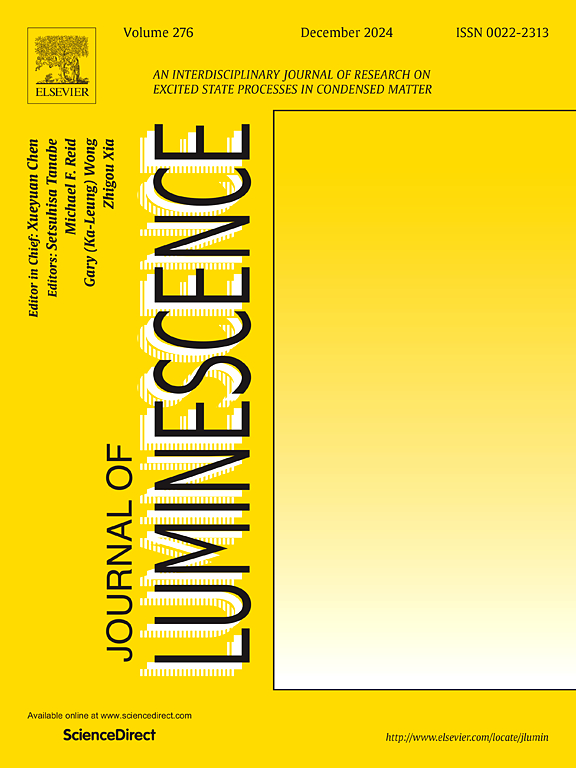掺镱CALYSO单晶光纤作为超短激光介质的潜力
IF 3.3
3区 物理与天体物理
Q2 OPTICS
引用次数: 0
摘要
首次制备了2 at的单晶纤维。采用LHPG法成功培养了% Yb:CaYAlO4 (Yb:CALYO)和Yb:CaY0.95Sc0.05AlO4 (Yb:CALYSO)。系统地研究了Yb:CALYO和Yb:CALYSO单晶光纤的结构、吸收、发射和寿命特性。此外,还考察了Yb3+浓度对这些性能的影响。计算了Yb:CALY(S)O单晶光纤的吸收截面,发现最强吸收峰位于979 nm处。2 at的发射截面。Yb:CALYO和Yb:CALYSO晶体纤维在982 nm和983 nm处分别为0.88 × 10−20 cm2和0.81 × 10−20 cm2,半峰全宽(FWHM)分别为85.37 nm和88.34 nm,对应于2F5/2→2F7/2的转变。研究了浓度为2 at的Yb:CALY(S)O晶体光纤在2F5/2能级上的荧光寿命。%分别为706 μs和682 μs。实验结果表明,Yb:CALYSO晶体光纤具有作为超短激光操作的激光介质的潜力。本文章由计算机程序翻译,如有差异,请以英文原文为准。
Potential of Yb-doped CALYSO single crystal fiber as a laser medium for ultrashort laser operation
For the first time, single crystal fibers of 2 at.% Yb:CaYAlO4 (Yb:CALYO) and Yb:CaY0.95Sc0.05AlO4 (Yb:CALYSO) were successfully grown using the LHPG method. The structure, absorption, emission, and lifetime characteristics of Yb:CALYO and Yb:CALYSO single crystal fibers were systematically investigated. Additionally, the influence of Yb3+ concentration on these properties was examined. The absorption cross-sections of Yb:CALY(S)O single crystal fibers were calculated, revealing that the strongest absorption peaks are located at 979 nm. The emission cross-sections for 2 at.% Yb:CALYO and Yb:CALYSO crystal fibers were determined to be 0.88 × 10−20 cm2 at 982 nm and 0.81 × 10−20 cm2 at 983 nm, with full widths at half maximum (FWHM) of 85.37 nm and 88.34 nm, respectively, corresponding to the transition of 2F5/2 → 2F7/2. The fluorescence lifetimes of the 2F5/2 energy level for Yb:CALY(S)O crystal fibers with a concentration of 2 at.% were calculated to be 706 μs and 682 μs, respectively. The experimental results indicate that Yb:CALYSO crystal fiber holds potential as a laser medium for ultrashort laser operation.
求助全文
通过发布文献求助,成功后即可免费获取论文全文。
去求助
来源期刊

Journal of Luminescence
物理-光学
CiteScore
6.70
自引率
13.90%
发文量
850
审稿时长
3.8 months
期刊介绍:
The purpose of the Journal of Luminescence is to provide a means of communication between scientists in different disciplines who share a common interest in the electronic excited states of molecular, ionic and covalent systems, whether crystalline, amorphous, or liquid.
We invite original papers and reviews on such subjects as: exciton and polariton dynamics, dynamics of localized excited states, energy and charge transport in ordered and disordered systems, radiative and non-radiative recombination, relaxation processes, vibronic interactions in electronic excited states, photochemistry in condensed systems, excited state resonance, double resonance, spin dynamics, selective excitation spectroscopy, hole burning, coherent processes in excited states, (e.g. coherent optical transients, photon echoes, transient gratings), multiphoton processes, optical bistability, photochromism, and new techniques for the study of excited states. This list is not intended to be exhaustive. Papers in the traditional areas of optical spectroscopy (absorption, MCD, luminescence, Raman scattering) are welcome. Papers on applications (phosphors, scintillators, electro- and cathodo-luminescence, radiography, bioimaging, solar energy, energy conversion, etc.) are also welcome if they present results of scientific, rather than only technological interest. However, papers containing purely theoretical results, not related to phenomena in the excited states, as well as papers using luminescence spectroscopy to perform routine analytical chemistry or biochemistry procedures, are outside the scope of the journal. Some exceptions will be possible at the discretion of the editors.
 求助内容:
求助内容: 应助结果提醒方式:
应助结果提醒方式:


